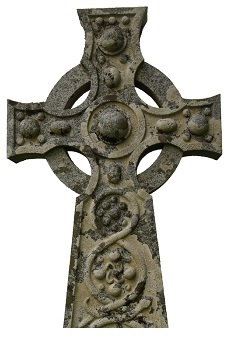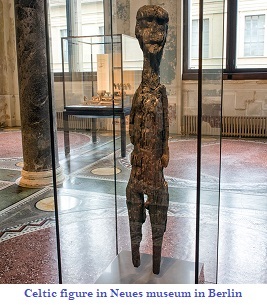

Ancient Celtic sculpture is a fascinating subject that has intrigued scholars, art historians, and art lovers for centuries. The Celts were a diverse group of people who lived in Europe from the late Bronze Age until the Roman conquest of Gaul in the first century BC. They were renowned for their artistic expression, which was characterized by intricate and abstract designs that were incorporated into various forms of art, including sculpture.
Ancient Celtic sculpture, like other forms of Celtic art, was heavily influenced by the surrounding cultures, including the Mediterranean, Roman, and Germanic cultures.
Ancient Celtic sculpture is a type of Celtic art that emerged from the late Bronze Age until the Roman conquest of Gaul in the first century BC. It was produced in various media, including stone, bronze, and wood, and was characterized by intricate designs, abstract motifs, and stylized human and animal figures.
The Celts produced a wide range of sculptures, including statues, reliefs, and decorative objects, which were used for both religious and secular purposes. Many of these sculptures were found in burial sites, indicating their significance in Celtic funerary practices.
Ancient Celtic sculpture is characterized by its intricate designs, abstract motifs, and stylized human and animal figures. The Celts were skilled metalworkers, and many of their sculptures were made of bronze.  These sculptures often depicted human figures, animals, or abstract motifs, such as spirals, knots, and interlace patterns.
These sculptures often depicted human figures, animals, or abstract motifs, such as spirals, knots, and interlace patterns.
One of the most distinctive features of Celtic sculpture is its stylization. The Celts often exaggerated certain features of the human and animal figures they depicted, such as elongated limbs, bulging eyes, and stylized hair. These features were often used to convey symbolic or spiritual meaning.
Another characteristic of ancient Celtic sculpture is its intricate designs. The Celts were skilled at creating intricate patterns and motifs, which were often incorporated into their sculptures. These designs were used to convey symbolic or spiritual meaning and were often based on natural forms, such as leaves, animals, or the human body.
Ancient Celtic sculpture was produced in various media, including stone, bronze, and wood. The Celts produced a wide range of sculptures, including statues, reliefs, and decorative objects.
Statues − Celtic statues were often made of bronze and depicted human figures or animals. These statues were often used for religious or secular purposes and were sometimes placed in burial sites. Many of these statues were highly stylized, with elongated limbs, stylized hair, and bulging eyes.
Many of these statues were highly stylized, with elongated limbs, stylized hair, and bulging eyes.
Reliefs − Celtic reliefs were often made of stone or bronze and were used to decorate buildings or other objects. These reliefs often depicted scenes from Celtic mythology or history and were highly stylized, with intricate designs and abstract motifs.
Decorative Objects − Celtic decorative objects were often made of bronze or other metals and were used to decorate weapons, jewelry, or other objects. These objects often featured intricate designs, abstract motifs, or stylized human or animal figures.
Ancient Celtic sculpture is significant for several reasons. First, it provides insight into Celtic culture, mythology, and spirituality. Many of the sculptures produced by the Celts were used for religious purposes, and their intricate designs and abstract motifs are thought to have held spiritual or symbolic meaning.
Second, ancient Celtic sculpture demonstrates the skill and artistic ability of the Celts. The intricate designs and stylized figures produced by the Celts demonstrate a high level of craftsmanship and creativity. The Celts were skilled metalworkers, and their ability to produce intricate sculptures in various media, including bronze, stone, and wood, is a testament to their artistic talent.
Finally, ancient Celtic sculpture has had a lasting impact on art and design. The intricate designs and abstract motifs used by the Celts have influenced various art movements throughout history, including the Arts and Crafts movement and Art Nouveau.
Ancient Celtic sculpture is a fascinating subject that provides insight into Celtic culture, mythology, and spirituality. The intricate designs, abstract motifs, and stylized human and animal figures produced by the Celts demonstrate a high level of artistic skill and creativity.
Ancient Celtic sculpture has had a lasting impact on art and design and continues to influence various art movements today. Its significance lies not only in its aesthetic beauty but also in its cultural and historical significance.
Q1. What was the significance of ancient Celtic sculpture in Celtic culture?
Ans. Ancient Celtic sculpture was significant in Celtic culture for its use in religious and secular practices. Many of the sculptures produced by the Celts were used for religious purposes and held spiritual or symbolic meaning. They also demonstrated the skill and artistic ability of the Celts and provided insight into their culture, mythology, and spirituality.
Q2. What were the characteristics of ancient Celtic sculpture?
Ans. Ancient Celtic sculpture was characterized by intricate designs, abstract motifs, and stylized human and animal figures. The Celts often exaggerated certain features of the figures they depicted to convey symbolic or spiritual meaning. They were also skilled at creating intricate patterns and motifs, often based on natural forms such as leaves, animals, or the human body.
Q3. What types of ancient Celtic sculptures were produced?
Ans. Ancient Celtic sculptures were produced in various media, including stone, bronze, and wood. They included statues, reliefs, and decorative objects. Celtic statues often depicted human figures or animals and were highly stylized. Reliefs were often used to decorate buildings or other objects and depicted scenes from Celtic mythology or history. Decorative objects were often used to decorate weapons, jewelry, or other objects and featured intricate designs and abstract motifs.